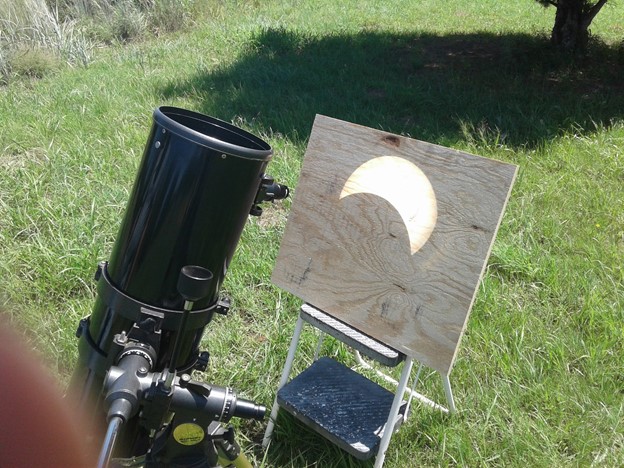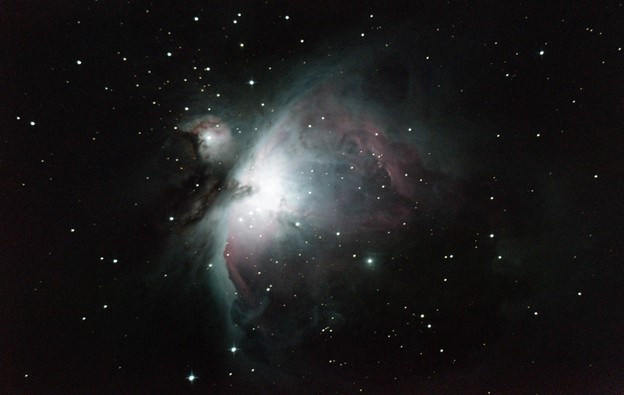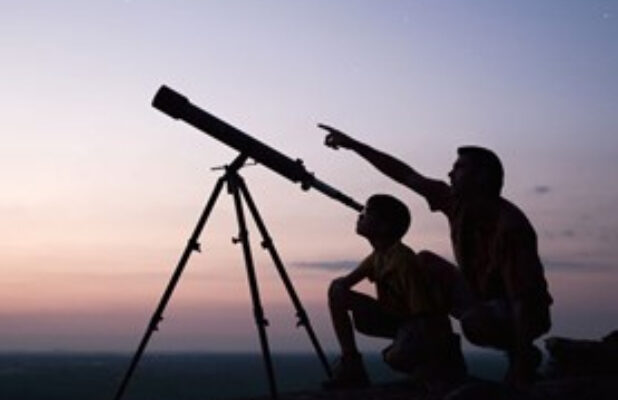I wrote a while back, and metaphorically, about how the process of mirror grinding and polishing is analogous in certain ways to shaping the mind and character of a child. More recently, still, and with the help of my 19 year-old “videographer” son, Gabriel (Gabe), I made a “how to” video demonstrating the proper procedures for safely removing, cleaning, and re-installing the primary mirror in a reflector telescope, without inadvertently scratching or otherwise permanently damaging the reflective surface. We made the video chiefly for the benefit of one of my daughters and sons in law, who are the new and proud owners of one of my old telescopes. The telescope in question has been stored away in a closet for several years unused, during which time the mirrors became very dirty.
It is said that “a mind is a terrible thing to waste”; in certain circles I occasionally fly in, the same is sometimes said of a good telescope. There is a big difference between a good telescope and a … not so good one, as you can readily imagine even if you know nothing of telescopes. This is undoubtedly true of minds as well, but that is a topic for another article specific to that particular subject matter.

The first telescope our family ever owned I purchased as a Christmas gift for our eldest son when he was about eight or nine years-old (he is now 34). It was one of those cheap toy (refractor) telescopes packaged and sold by Tasco or some company like that, similar to the one in the image I’ve included above. In spite of its inferior quality all around, that toy telescope provided my son and me many hours of “sky watching” pleasure together way back when. It was also the telescope we both cut our star-gazing teeth on.
By the time my daughter above-mentioned came of age and maturity enough to realize what a telescope is and what one is for, we had already moved on to a bigger (reflector) telescope that incorporated better optics and a much superior (equatorial) mount. She has therefore never known a day of her life when we did not have a quality telescope that we did not put to good use on at least a semi-regular basis, as time and opportunity permitted. Her husband, on the other hand, has never owned or had any kind of experiences with a telescope, its use or its upkeep. But neither had I at his age. We took the time to make the “how to” video because my daughter expressed concern to me about cleaning the optics on the telescope, as she was afraid she has forgotten the proper procedures for doing it safely since she’s been away from home. She might have forgotten how to do it safely, but she certainly hasn’t forgotten those old lessons about doing it properly or not doing it at all. I’ll happily take at least some of the credit for instilling that cautionary, “better safe than sorry” attitude in her, but some of the credit also goes to her paternal grandfather (my father), who was apt to remind me from time to time during my formative and early adult years that, “anything worth doing is worth doing right.”
Given the contents of the preceding paragraphs, it might surprise you to learn that I’m generally not any more aware of upcoming astronomical events than virtually anyone else is, in spite of my decades-long interest in astronomy and the multiple thousands of dollars of hard-earned money I’ve invested in its pursuit as an amateur astronomer during that time. I no longer subscribe to, nor read, the astronomy journals on a regular basis like I used to when amateur astronomy occupied more of my “leisure time” and captured a larger share of my interest.
That said, there is a fair chance at least that you knew about the historic conjunction of Saturn and Jupiter on the night of Winter Solstice, 2020, before I did. Because I’ve been at this for years, however, I can look up at the night sky with the naked eye and immediately tell you if Jupiter or Saturn or Mars is visible (Mercury and Venus are “no brainers,” and the rest of the planets are not visible with the naked eye). There is a reason the ancients named these objects “planeta” (wanderers); against the backdrop of the “fixed stars” and their apparent formations, the planets are continually, and noticeably, migrating in their positions along the ecliptic from night to night. This is how I first came to realize something that seemed out of the ordinary was happening with the two “gas giants”; I had noticed them moving closer together (from our line of sight) weeks before the event. As such, curiosity prompted me to look into it on the astronomy app I have installed on my devices.
One of my personal ‘rules of thumb’ that I strive to follow more or less closely is to avoid assuming much of anything about other persons, and I am known (by persons who know me well) to strongly advise against it when the subject comes up. I think it nevertheless safe to assume certain things about people in general, or as a general rule. E.g., I assume most people are more or less like me in that they had just as soon “kill two birds with one stone” when that is a practicable goal. In the particular case of the “how to” video, my initial aim was to kill at least three birds with one stone, while aiming at knocking down a fourth to boot. Doubling your efforts is a fine thing, but if you can triple or quadruple them, then so much the better.

The mirrors on my personal telescope I used for demonstration purposes in the video weren’t especially dirty since I take particular care to insure dust and lint and such has a hard time finding its way into the telescope when it isn’t being used. The reflective surface on a telescope mirror is very thin and fairly delicate. That being the case, and even with the advent of protective coatings now routinely added onto telescope mirror surfaces, it is not a good idea to clean it more often than necessary, even when taking all the proper precautions. I would not have had sufficient reason to clean the mirror this time were it not for the timeliness of making the video, and using the opportunity for replacing a broken finder scope mount while we were at it (the second ‘bird’ killed). Since I only clean the optics perhaps once a year on average, opportunities for sharing my expertise on the matter with others are few and far between. This time around I made the entire process a school lesson for the kids still at home (the third bird), in conjunction with making the video and replacing the broken part. As to the fourth ‘bird,’ I’ll get to that in a bit.
By “a mind is a terrible thing to waste,” I take it that the adage is partly meant to convey the idea expressed in another old saying, namely “use it or lose it.” Telescope optics will invariably collect dust and lint and other foreign matter more or less corrosive and harmful over time, whether in use or not. It is therefore periodically necessary to remove the mirrors and give them a thorough cleaning. Otherwise the telescope will only perform at some fraction below, or less than, 100% of its full potential, whatever that potential may be. A telescope’s potential is best expressed in terms of light gathering capability, not “power.” “Power,” in telescope terminology, usually refers to magnification. But magnification is wholly dependent on light gathering capability, coupled with, in the case of a reflector, the primary mirror’s quality and reflective characteristics.
If you’ve owned a particular telescope and put it to regular use for an extended period of time, you undoubtedly have a very good idea of what it is capable of and, therefore, at what percentage of its capability it is performing at any given time, under any given conditions. If your telescope is performing at, say, 90% of its capability or above, it is generally not advisable to clean the mirrors; if, on the other hand, it is performing at, say, 80% of its capability or below, then it is probably time to start thinking about doing the dreaded deed, thereby restoring its optimum capability of producing visually stunning images at the eyepiece.
To clean a telescope mirror safely, certain tools must be ready at hand, and certain procedures followed more or less closely. If you ever served as a technician of any kind in the military, you probably know what a seven-level screwdriver is. I will use nothing larger than a seven-level screwdriver for working on the telescope unless absolutely necessary. Another “must have” tool for cleaning the mirrors in a telescope is an optics-grade brush. Perhaps you’re into photography, or you own guns with scopes mounted on them. If so in either case, and/or both, you know the difference between an optics-grade brush, and its lesser counterpart. A third item is a pan or a dish of some sort, slightly larger in diameter and depth than the mirror itself. It doesn’t hurt to have a can of compressed air on hand as well. Finally, a great deal of patience is an absolute requirement.
The actual cleaning of the mirror surface involves the mixing of a simple solution made up of distilled water, rubbing alcohol, and liquid dishwashing soap. The primary mirror is immersed in this solution for twenty to thirty minutes, during which time the majority of foreign matter capable of damaging the mirror surface will simply release and float away. The contaminated contents of the pan is then emptied and the pan rinsed. A new solution is made and the mirror immersed therein for an additional ten to fifteen minutes. Once this process is complete, the more stubborn foreign matter that remains clinging to the surface must be removed by way of gently (very gently!) going over the entire surface in small circular motions with a cotton ball while the mirror remains fully immersed in the solution.
Once this step is complete, the mirror is ready to be removed from the solution and rinsed under cold tap water. It is then set aside, standing on edge, to air dry. Depending on how impatient I am with the rate at which the mirror is drying, I will sometimes get the ol’ hair dryer out, turn it on “low,” and thereby help shorten the drying time a bit. Once the mirror is re-installed in its cell, and the cell in the telescope tube, there is almost invariably at least some slight realignment of the optics (the primary and secondary mirrors) that must be done. If you have a well-made telescope like mine, and a little experience under your belt, this is a fairly simple and quick procedure. All you need is a good dark and clear night, and a medium magnitude star high above the horizon where less than ideal atmospheric conditions is generally less of a factor.
Aligning the mirrors is called collimation. The procedure involves bringing the star into the center of the field of view in the eyepiece, then running it outside of prime focus. A good telescope with parabolic optics will yield a dark spot in the center with several thin, concentric circles of light surrounding it. If these circles are not equally spaced and perfectly circular in shape, with the dark spot located precisely at their center, the mirrors are out of alignment.
There are three alignment screws installed on the back of the primary mirror cell. By running the narrowest part of the misshaped image to the edge of the field of view farthest from it by use of one or more of these equidistant adjustment screws, and repeating the process as needed, the distortion in the concentric circles will eventually be taken out. At which point the mirrors are perfectly aligned; the telescope is now performing at its peak, and will yield crisp images when brought to a fine focus.

I don’t know if any of what I’ve written above will ever be of any practical use to you or not. I’m hoping it will, but not necessarily in the way you might think. If my mirror grinding/shaping-the-mind-and-character-of-a-child analogy bears any truth, it follows that the necessity of periodically, and safely, cleaning the reflective surface of the mind bears its own analogous qualities in a similar, albeit different, way.
A few nights after we made the “how to” video, the kids and I had our first opportunity to put the newly-cleaned mirror to the test. The viewing conditions were almost perfect – cold, clear, moonless night and stable atmosphere. We aimed the telescope at the Orion Nebula high in the eastern sky, and, as I knew would be the case, the image yielded through the eyepiece initially was less than pristine. After giving each of them his or her turn at the eyepiece, I explained to the kids that the image was fuzzy because the mirrors were slightly out of alignment, and what we would need to do to correct the problem. Five minutes and a little adjustment later, the telescope was functioning at very near 100% of its peak capability. I brought the Orion Nebula back into view, and to a fine focus. Without a word, I stepped away from the eyepiece and gestured to our 9 year-old daughter, Hannah, to take a second gander. “Wowwww!; that is sooooo beautiful!,” she exclaimed. At his turn, our 10 year-old son, Josh, pronounced, with bated enthusiasm typical of the male of the species, “that is incredible!”
They were both right; it was both beautiful and incredible. You might say it was incredibly beautiful; a sight these eyes at least never tire of viewing at various magnifications through the eyepiece; a sight I trust, moreover, that theirs will never tire of either, now that I have them hooked (fourth ‘bird’ downed!). The greater joy, though, is in watching and listening to each of the kids’ reactions the first time they have an opportunity to see the Orion Nebula or Saturn and her rings, or even the various features of the moon, etc., through the eyepiece. “The heavens,” the Psalmist wrote, “declare the glory of God.” This is perfectly evident with or without the aid of a good telescope well kept and well maintained. However, and for a relatively small investment worth every penny and then some, you and your children can enjoy many hours during their precious formative years star-gazing together, exploring the incredible beauty of the works of God’s own hands ‘up close and personal.’
A quality telescope is a handy instrument to have at your disposal to aid in shaping the minds and character of your children, while simultaneously spending quality time together exploring and learning about God’s universe. It is also a handy instrument to have around to aid in gently washing the impurities off of the surface of your childrens’ minds when needs be. Which is to say whenever it becomes evident to you that their minds and character you’ve worked so diligently to shape and polish to a highly reflective state are yielding less than pristine thought-images due to the (inescapable) accumulation of foreign matter over time more or less corrosive and harmful. Occasionally bathe their minds in the Word of God and His righteousness; and following each thorough cleansing, periodically and carefully done, test the alignment of the reflective surfaces of their minds’ eyes; slightly adjust or collimate as needed, and enjoy the restoration to uncorrupted purity a thin layer of foreign matter had, for a time and a season, prohibited from coming forth.
Train up a child in the way he should go: and when he is old, he will not depart from it.







Our children are much too young to enjoy telescopes at this time but it certainly sounds like a rewarding hobby at some point in the future.
Yes, I know exactly what you mean – it never would have occurred to me, and in fact never did occur to me previously, to purchase a telescope for school/family use before our eldest son got to the equivalent of the 3rd grade level (we don’t do grade levels, but that’s a whole ‘nother topic for a different time) and our studies began to take on a more scientific flavoring.
Thanks for the comment.
TM,
I owned a telescope for 2 years before I even dared to assemble it last summer. Now it is sitting in our shed, unused and dusty. But your essay has inspired me to FINALLY to put it use. Even if we do it wrong, we will indeed be learning about God’s universe, whether that be through watching the stars or spending time together as a family. Either way, it’ll be a blessing. Thanks for the stellar essay, friend!
Thanks for the comments, and for the compliment, on the essay, DM.
I’m very happy to hear that your telescope will no longer ‘go to waste’; that you and your boys will be putting it to its proper use henceforward, and that my little write-up might have had at least something to do with that. And, as you well know, one of the greatest joys of homeschooling our children is that we parents are often learning new and useful things right along with them in the very process; principles and information that, in the absence of homeschooling, we might not have ever had good reason to explore and learn. This has certainly been the case in our little family’s homeschooling experience, and it is a big reason why I, along with you, advocate so strongly for homeschooling. Lifelong learning, as you so often reiterate. Another biggie is of course that the public schools are horrible at education, properly speaking, and are indeed our avowed and mortal enemies t’boot. But that’s of course another matter for another day.
Thanks again for the comment. I doubt I need to state the obvious, but I for one am a big fan of your work. Keep fighting the good fight, ma’am.
-Terry